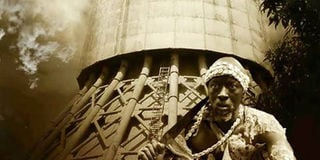Teaching history made easy with film

The illustration of the movie about the Uganda Martyrs while below the cover of the movie Shaka Zulu. Educationists believe integrating film in teaching of History will make students uinderstand better. pHOTOs BY eric ntalumbwa
What you need to know:
Movies such as Ghost and Darkness, Shaka Zulu: The last Great Warrior, Mandela: Long Walk to Freedom, Final Flames of the Uganda Martyrs, Uganda Martyrs Story have kept history fresh and memorable. It is time we used film as a tool to simplify the learning of History.
In 1898, a railroad camp in Tsavo, Kenya was terrorised over several months by a pair of lions who killed and ate railroad workers during the building of the Uganda-Mombasa Railway before being shot and killed by Col John Henry Patterson, a British military engineer.
The events inspired the making of Ghost and Darkness, an American historical adventure film which was released in 1996.
“I was impressed by the unsung efforts of Samuel, the Kenyan foreperson. He assisted Col Patterson to take the fight forward after the death of famous hunter Charles Remmington. We watched the movie many years ago and it enabled me answer questions about the man-eaters of Tsavo,” says Andrew Mulwanyi, a local television producer.
Museum simplifies learning
In the same vein, Ssemagulu Royal Museum has embarked on simplifying the history syllabus by using film as a tool of learning.
“It is one thing to give students notes about Imperial British East African Company, but another for students to watch Sir William Mackinnon and other stories about him beyond the class notes. Students will find his roots and what he studied, and understand what they have been taught about him better,” explains John Ssempebwa, the curator.
In the meantime, the museum educates students about places that are not taught in class but were named after the first foreigners such as Ahmed Bin Ibrahim.
They see sculptures that make history memorable and fun. Ssempebwa says they also reward students with cash prizes for remembering history lessons as a form of motivation.
Acting
But Ssempebwa also encourages schools to act skits/films based on the History syllabus. “When a school chooses to act the life and death of Omukama Kabalega, 1900 Buganda Agreement, or Lamogi Rebellion, we write the script, then cast at the school. The cast comprises students, teachers, and the local community. Thereafter, we shoot the film,” reveals Ssempebwa.
He says no film shot by a school has been released, but when they do, there will be 100 films based on Ugandan legends.
“Schools will be exchanging films. Initially schools might sell these copies without putting them on the market. We are not going to stress with the pirates market of VJs. We shall give the soft copy to the school and it will be the head teacher to keep that copy. They will not sell until they recover the money put into making the film because once you sell a copy, it will find its way to Luwuum Street,” notes Ssempebwa, a History enthusiast.
He adds that Ugandan history is shaped by people some of whom are still alive, but no one is telling their stories through film for the next generation.
“We have Mill hill fathers or Janan Luwuum, a saint whose statue is in Canterbury. Gladly the director of Janan schools has approved our request and they are going to act about his life, challenges, impact and death. Other figures we should consider are Paul Kawanga Ssemwogerere, Apolo Nsibambi, Ruhakana Rugunda, Kirunda Kivejinja, Rebecca Kadaga or even Hajj Nadduli and Ken Lukyamuzi, among others.
Impact
Ssempebwa does not think a student can fail a question on slave trade when tasked to act the story. He is, however, bothered by schools that act foreign stories.
“Why should a Ugandan school only act Shakespearean plays? Idi Amin has only been portrayed as a rapist, cannibal, goon, and heartless tyrant yet when you interface with his son Jaffar he says his father was a happy person who loved hanging out,” he notes.
Ssempebwa is also confident that Uganda will have content that noone has put out in the public and urges Ugandans to shoot their own stories and shape the narrative.
“Imagine there is no single film about Apollo Milton Obote to depict his troubles with Buganda and how he survives an assassination at Lugogo, and his overthrow. If we give chance to foreigners to shoot a movie about Kabalega, they might demean him and alter history,” he stresses.
WE ARE VISUAL LEARNERS
For many high school students, and adults too quite frankly, pictures really are worth a thousand words. That’s how many people learn, and that’s why teaching history with film is a great way to make an otherwise potentially tedious subject a blast to get into.
This is all well and good, but is video actually preferable over the written word when it comes to retention, education, and experience? Definitely, or at least according to an article in the Huffington Post entitled Research Confirms Video Improves Learning Results. It is based on a survey taken of 500 educational professionals from 300 different educational institutes. According to the results of the survey, video “may be the best way to improve learning styles, especially when it comes to remembering key facts and figures.”
“Forrester Research estimates one minute of online video equates to approximately 1.8 million written words,” wrote author Michal Tsur of Kaltura, the company that conducted the survey. “In addition, 90 percent of information transmitted to the brain is visual, and visuals are processed 60,000 times faster in the brain than text. This indicates visual education aids like video can improve learning styles and increase the rate at which we retain information.” What this means is that we are inherently visual learners.
Some of the useful films
•Ghost and Darkness
•Shaka Zulu: The last Great Warrior
•Mandela: Long Walk to Freedom
•Final Flames of the Uganda Martyrs
•Uganda Martyrs Story
Source:wabisabi learning




